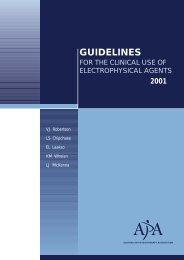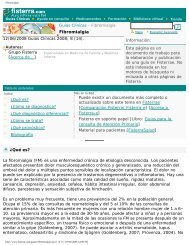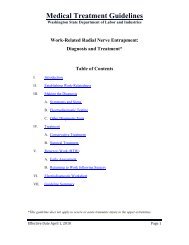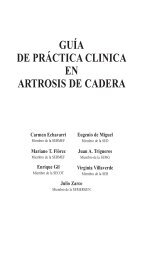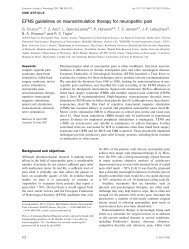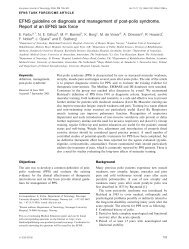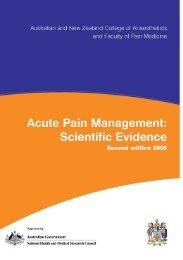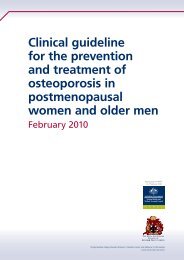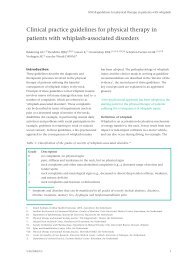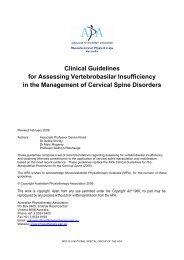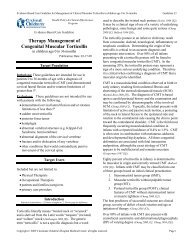Practice Parameter and Literature Review of the Usefulness of ...
Practice Parameter and Literature Review of the Usefulness of ...
Practice Parameter and Literature Review of the Usefulness of ...
Create successful ePaper yourself
Turn your PDF publications into a flip-book with our unique Google optimized e-Paper software.
<strong>Practice</strong> <strong>Parameter</strong>: Carpal Tunnel SyndromeCriteria Met (normal population study 5/6: 1,3,4,5,6) Source:Bushbacher 1999 monograph. Abstract: Study performed todetermine effect <strong>of</strong> body fat on NCS parameters. There was nocorrelation between Body Mass Index <strong>and</strong> conduction velocities butsensory/mixed nerve amplitudes were 20-40% lower in <strong>the</strong> obesecompared to thin subjects.33. Buschbacher RM. Median 14-cm <strong>and</strong> 7-cm antidromic sensorystudies to digits two <strong>and</strong> three. Am J Phys Med Rehabil 1999;78:S53-S62. Criteria Met (normal population study 5/6: 1,3,4,5,6) Source:Medline Search identified Bushbacher 1999 Monograph. Abstract:The purpose <strong>of</strong> <strong>the</strong> study was to create a large database <strong>of</strong> normalvalues for <strong>the</strong> antidromic median sensory conduction to D2 <strong>and</strong> D34with stimulation at <strong>the</strong> wrist (14 cm) <strong>and</strong> palm (7 cm) bilaterally in258 normal subjects. Analysis <strong>of</strong> variance demonstrated thatincreasing age <strong>and</strong> increasing body mass index correlated withdecreasing amplitudes <strong>and</strong> area. For peak latency measurements, 50%<strong>of</strong> <strong>the</strong> 14 cm latency was attributed to <strong>the</strong> wrist-to-palm segment. Theupper limit <strong>of</strong> normal increase in amplitude from wrist-to-palmstimulation is 50-55%.34. Buschbacher RM. Median nerve motor conduction to <strong>the</strong> abductorpollicis brevis. Am J Phys Med Rehabil 1999;78:S1-S8. Criteria Met(normal population study 5/6: 1,3,4,5,6) Source: Medline Searchidentified Bushbacher 1999 Monograph. Abstract: The purpose <strong>of</strong> <strong>the</strong>study was to create a large database <strong>of</strong> normal values for <strong>the</strong> medianmotor conduction to <strong>the</strong> APB including <strong>the</strong> amplitude (10.2 ± 3.6mv), distal latency (3.7 ± 0.5 ms) <strong>and</strong> conduction velocity (57 ± 5m/s). Analysis <strong>of</strong> variance demonstrated that age affects <strong>the</strong> distallatency, amplitude, area <strong>and</strong> forearm NCV. Gender affects distallatency <strong>and</strong> forearm NCV. Height has no significant effect on any <strong>of</strong><strong>the</strong>se measurements.35. Buschbacher RM. Median nerve F-wave latencies recorded from <strong>the</strong>abductor pollicis brevis. Am J Phys Med Rehabil 1999;78:S32-S37.Criteria Met (normal population study 5/6: 1,3,4,5,6) Source: MedlineSearch identified Bushbacher 1999 Monograph. Abstract: Thepurpose <strong>of</strong> <strong>the</strong> study was to create a large database <strong>of</strong> normal valuesfor <strong>the</strong> median F-waves by analysis <strong>of</strong> F-wave responses from <strong>the</strong>APB to ten consecutive supramaximal stimuli applied to <strong>the</strong> wrist <strong>of</strong>each arm <strong>of</strong> 195 asymptomatic subjects without risk factors forneuropathy. An analysis <strong>of</strong> variance demonstrated that <strong>the</strong> minimum<strong>and</strong> mean F wave latentcies are dependent on age, gender <strong>and</strong> height.36. Buschbacher RM. Mixed nerve conduction studies <strong>of</strong> <strong>the</strong> median <strong>and</strong>ulnar nerves. Am J Phys Med Rehabil 1999;78:S69-S74. Criteria Met(normal population study 5/6: 1,3,4,5,6) Source: Medline Search.Abstract: Normal data from a reference population <strong>of</strong> 248 subjects,age range 19-79 yr, 45% males tested bilaterally for median <strong>and</strong> ulnarmixed nerve orthodromic conduction study across <strong>the</strong> wrist(conduction distance 8-cm) <strong>and</strong> <strong>the</strong> differences in latencies (onset <strong>and</strong>peak) for both studies. For both median <strong>and</strong> ulnar nerves, <strong>the</strong> meanonset latency was 1.6 ± 0.2 ms, <strong>and</strong> <strong>the</strong> mean peak latency was 2.1 ±0.2 ms. Mean side-to-side difference for <strong>the</strong> median <strong>and</strong> ulnar onset<strong>and</strong> peak latencies was 0.0 ± 0.2 ms. The mean difference betweenonset <strong>and</strong> peak latencies between <strong>the</strong> nerves was 0.0 ± 0.2 ms.Because <strong>the</strong> stimulus artifact may obscure <strong>the</strong> onset in some cases, <strong>the</strong>peak latency is <strong>the</strong> preferred value. Amplitude measurements, but notlatency measurements, were dependent on age, gender <strong>and</strong> body massindex (measure <strong>of</strong> obesity).37. Cannon BW, Love JG. Tardy median palsy; median neuritis; median<strong>the</strong>mar neuritis amenable to surgery. Surgery 1946;20:210-216.Background Reference. Source: Gelbermann, 1980.38. Carroll G. Comparison <strong>of</strong> median <strong>and</strong> radial nerve sensory latenciesin <strong>the</strong> electrophysiological diagnosis <strong>of</strong> carpal tunnel syndrome.Electroencephalogr Clin Neurophysiol 1987;68:101-106. Criteria Met(6/6: 1,2,3,4,5,6) Source: Medline Search. Abstract: With stimulationon index finger <strong>and</strong> thumb, orthodromic SNAPS were recorded at <strong>the</strong>wrist in 100 healthy h<strong>and</strong>s <strong>and</strong> 161 CTS h<strong>and</strong>s. When differences in<strong>the</strong> distal latencies between <strong>the</strong> median <strong>and</strong> radial nerves were used asabnormal, 60% sensitivity was obtained. The median-radialcomparison increased <strong>the</strong> yield <strong>of</strong> abnormalities in 17 <strong>of</strong> 161 h<strong>and</strong>swhen compared to <strong>the</strong> index DSL latency alone.39. Casey EB, LeQuesne PM. Digital nerve action potentials in healthysubjects, <strong>and</strong> in carpal tunnel <strong>and</strong> diabetic patients. J NeurolNeurosurg Psychiatry 1972;35:612-623. Criteria Met (6/6:1,2,3,4,5,6) Source: Palliyath, 1990. Abstract: With stimulation <strong>of</strong> <strong>the</strong>middle finger, median sensory nerve conduction velocities werecalculated from <strong>the</strong> onset <strong>and</strong> peak latencies <strong>of</strong> SNAPs recorded from<strong>the</strong> wrist <strong>and</strong> proximal phalanx with surface electrodes. Theconduction velocities <strong>of</strong> both <strong>the</strong> digit-wrist <strong>and</strong> distal-proximal digitsegments were reduced uniformly in 18 patients with diabeticpolyneuropathy. In contrast, <strong>the</strong> conduction velocity <strong>of</strong> <strong>the</strong> distalproximaldigit segment was <strong>of</strong>ten normal while <strong>the</strong> conductionvelocity <strong>of</strong> <strong>the</strong> digit-wrist segment was reduced in 16 CTS patients.40. *Cassvan A, Ralescu S, Shapiro E, Moshkovski FG, Weiss J. Median<strong>and</strong> radial sensory latencies to digit I as compared with o<strong>the</strong>rscreening tests in carpal tunnel syndrome. Am J Phys Med Rehabil1988; 67:221-224. Criteria Met (3/6: 1,3,5) Source: Medline Search.41. *Cassvan A, Rosenberg A, Rivera LF. Ulnar nerve involvement incarpal tunnel syndrome. Arch Phys Med Rehabil 1986;67:290-292.Criteria Met (1/6: 3) Source: Medline Search.42. *Chang CW, Lien IN. Comparison <strong>of</strong> sensory nerve conduction in <strong>the</strong>palmar cutaneous branch <strong>and</strong> first digital branch <strong>of</strong> <strong>the</strong> median nerve:a new diagnostic method for carpal tunnel syndrome. Muscle Nerve1991;14:1173-1176. Criteria Met (5/6: 1,2,3,5,6) Source: MedlineSearch. Abstract: Comparison <strong>of</strong> orthodromic SNC in <strong>the</strong> medianpalmar cutaneous branch <strong>and</strong> digit I nerves was evaluated in 50 CTSpatients <strong>and</strong> 40 healthy persons. The abnormalities were defined as<strong>the</strong> differences in latencies <strong>and</strong> SNCVs <strong>of</strong> more than mean plus 2.5SD<strong>of</strong> controls. Abnormalities were noted in 84% (36 <strong>of</strong> 43 patients) <strong>of</strong><strong>the</strong> sensory latency comparisons <strong>and</strong> 77% (33 <strong>of</strong> 43 patients) <strong>of</strong> <strong>the</strong>SNCVs comparisons after exclusion <strong>of</strong> 7 CTS patients whose D1SNAP was unobtainable. This method may serve as an adjunctivetechnique in <strong>the</strong> diagnosis <strong>of</strong> CTS.43. Chang MH, Chiang HT, Ger LP, Yang DA, Lo YK. ClinNeurophysiol 2000;111:1039-1044. The cause <strong>of</strong> slowed forearmmedian conduction velocity in carpal tunnel syndrome. Criteria Met(5/6: 1,3,4,5,6) Source: Medline Search. Abstract: A prospectivestudy <strong>of</strong> 20 CTS patients with slowing (50 m/s)forearm CV <strong>and</strong> 20 normal control subjects. Median motor nerve CVwas calculated from <strong>the</strong> results <strong>of</strong> recordings from <strong>the</strong> APB withstimulation at <strong>the</strong> wrist, elbow, mid-arm <strong>and</strong> axilla. The authorshypo<strong>the</strong>sized that if <strong>the</strong> slowing <strong>of</strong> forearm CV was due to conductionblock <strong>of</strong> large myelinated fibers at <strong>the</strong> wrist, median forearm CV <strong>and</strong>also proximal median CV would be decreased. However, <strong>the</strong> reducedmedian CV was limited to <strong>the</strong> forearm segment. The authorsconcluded that <strong>the</strong> data indicated that slowing <strong>of</strong> median forearm CVin CTS is due to retrograde axonal atrophy ra<strong>the</strong>r than conductionblock.44. Chang MH, Liao KK, Chang SP, Kong KW, Cheung SC. Proximalslowing in carpal tunnel syndrome resulting from ei<strong>the</strong>r conductionblock or retrograde degeneration. J Neurol 1993;240:287-290.Criteria Met (4/6: 1,3,4,6) Source: Medline Search. Abstract:Decreased CV in <strong>the</strong> median nerve forearm segment has beendocumented by st<strong>and</strong>ard NCS in CTS patients. A new techniquemodified from <strong>the</strong> method <strong>of</strong> Stoehr et al. <strong>and</strong> Pease et al. was used todetermine <strong>the</strong> forearm median nerve action potentials (FNAP)amplitude <strong>and</strong> forearm nerve conduction velocity (FNCV) proximalto <strong>the</strong> wrist. Age matched subjects with non-specific numbnessreferred to <strong>the</strong> laboratory <strong>and</strong> patients with CTS were studied by bothst<strong>and</strong>ard NCS <strong>and</strong> <strong>the</strong> new FNAP methods. CTS patients weredivided into subgroups according to <strong>the</strong> severity <strong>of</strong> abnormalities onst<strong>and</strong>ard median sensory <strong>and</strong> motor NCS. There was a significantdecrease in FNAP amplitudes proportional to severity <strong>of</strong> <strong>the</strong> CTS, butFNCV was reduced to a lesser extent. In addition, <strong>the</strong> st<strong>and</strong>ardforearm median motor CV (MMCV) correlated well with severity, but<strong>the</strong> reduced MMCV did not correlate with <strong>the</strong> decreased FNCV. Weinterpreted <strong>the</strong>se findings to indicate that <strong>the</strong> reduced forearm MMCVin CTS results primarily from <strong>the</strong> block <strong>of</strong> <strong>the</strong> faster conductingmedian motor nerve fibers at <strong>the</strong> wrist ra<strong>the</strong>r than from retrogradedegeneration <strong>of</strong> median motor nerve fibers.45. Charles N, Vial C, Chauplannaz G, Bady B. Clinical validation <strong>of</strong>antidromic stimulation <strong>of</strong> <strong>the</strong> ring finger in early electrodiagnosis <strong>of</strong>mild carpal tunnel syndrome. Electroencephalogr Clin Neurophysiol1990;76:142-147. Criteria Met (4/6: 1,3,5,6) Source: Medline Search.Abstract: The following techniques were studied: (a) orthodromicstimulation <strong>of</strong> <strong>the</strong> index finger with recording over <strong>the</strong> median nerveMuscle & Nerve Supplement X 2002 S961



